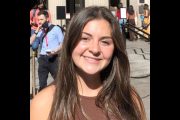
The nation is divided. Fundamental issues of religion, morality, economics, and fundamental civil liberties and the responsibilities of elected officials are being debated — often in angry tones — by people whose viewpoints regularly have every appearance of being mutually irreconcilable. There is a perception that, for good or for ill, the nation is truly at a crossroads that will define its character for generations to come.
But Lee Dye, writing in an opinion article for ABCNews.com, has a different theory about those who are contending for such fundamental issues: “Maybe they are just bullies.”
Mr. Dye’s article (“Can Someone Please Turn Down the Rhetoric?”) begins with the assertion:
Those bombastic self-appointed spokespersons who rant from both the political right and left are likely driven by the conviction that their extreme views are shared by the majority of the members of their political party, but they probably are wrong, according to new research.
Lest anyone be deluded into thinking this assertion is actually even handed, the link for “extreme views” takes readers to the now-infamous Department of Homeland Security "report" on rightwing extremism. If there is actually leftwing extremism to be found, Mr. Dye does not cite any examples.
But what is the research Mr. Dye alludes to demonstrating the disparity between “bombastic self-appointed spokespersons who rant” and the “majority of members of their political party”? Dye continues:
The research, conducted over several years at Stanford University and published in the Journal of Experimental Social Psychology, suggests that the conviction that they speak for the masses is critical to their decision to shout out their opinions, regardless of how polarizing they may be.
"We are arguing that one of possibly many reasons people express their opinions is the perception that they are more popular than they really are," co-author Kimberly Rios Morrison said in a telephone interview.
Morrison, who is now with Ohio State University in Columbus, conducted a series of studies with psychologist Dale Miller of Stanford on the role of self perception in political extremism.
Although the institutions associated with the study are considered by many to be prestigious, the actual applicability of the study under consideration to the current political seems questionable:
The two carried out their research at a time when Stanford was embroiled in controversy. The university prohibited alcohol in common areas of freshman dorms, leading to heated arguments, as might be expected. Students participating in three different studies were asked to rate themselves as pro, moderate, or anti-alcohol.
"There’s this stereotype that college students are very pro-alcohol, and even most college students believe it," Morrison said. But "most students think of themselves as less pro-alcohol than average."
Students rated themselves on a scale of 1 (very opposed) to 9 (very strongly in favor) and were asked if they would be willing to express themselves publicly. Perhaps not surprisingly, students who were really in favor of booze were most willing to speak out.
But was that because they thought most of their fellow students agreed?
Maybe, according to one of the studies. In that study the students were given fake data indicating that many Stanford students held conservative, anti-alcohol views. Pro-alcohol participants who were confronted with evidence that they were likely in the minority were far less likely to voice their opinions, let alone shout them from the rooftops.
As tempting as it would be to dwell on the fact that the underreported position in the study was the conservative position, an immediate methodological difficulty presents itself when one attempts to apply the study to the current political crisis in America. First, the debate over alcohol in the dorms, while no doubt fascinating to students and faculty alike, did not go to the heart of the mission of the university, but to the location of what one might call an "optional activity.’ If the question had been: Should the university stop offering classes and be transformed into a homeless shelter, or, should the university sell off the dorms and put condominiums in their place, a very different dynamic might have been at work in the expression of student opinion.
The applicability of the study also fails when one considers the element of voluntary association: When a person chooses to ‘support’ a radio talk show host, television commentator, or print or internet opinion writer, that is a matter of choice. It may be depressing to think that someone pays attention to the views being expressed by one individual or another, but no one is being forced to listen and to read. And advertising dollars follow the listeners and readers because they know there’s a market to be found.
Mr. Dye concludes his article:
It’s probably safe to assume, however, that the volume is being turned up in political rhetoric these days largely because of an ancient human drive. As my column pointed out last week, insecurity can drive a person to extreme limits, even to the abuse of coworkers. Maybe that’s what drives so many political extremists these days.
Maybe they are just bullies.
Perhaps. But in a free country there are many ways in which an individual may choose to participate in the discussion. Mr. Dye has a quite enviable platform at ABCNews.com from which he chooses to share his opinions; it would be unfortunate if he wasted that opportunity on finding fault with others who have been afforded similar opportunities.



